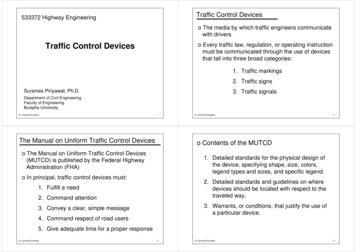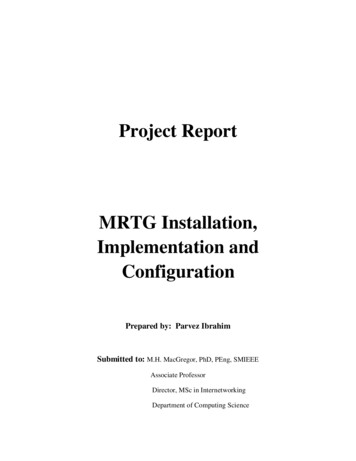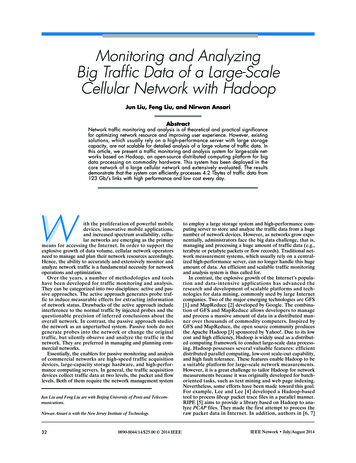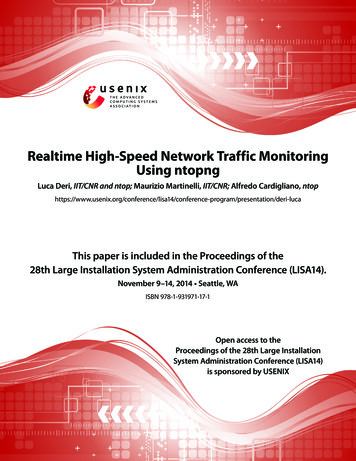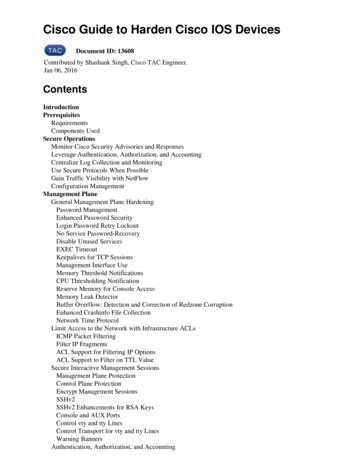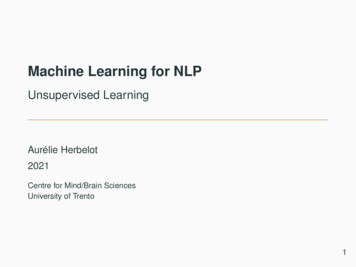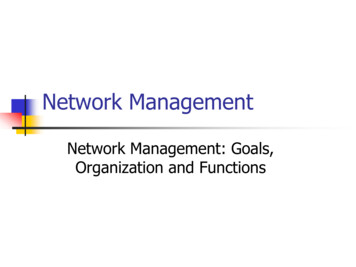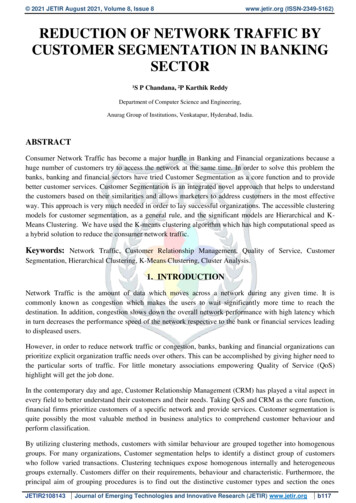
Transcription
2021 JETIR August 2021, Volume 8, Issue 8www.jetir.org (ISSN-2349-5162)REDUCTION OF NETWORK TRAFFIC BYCUSTOMER SEGMENTATION IN BANKINGSECTOR¹S P Chandana, ²P Karthik ReddyDepartment of Computer Science and Engineering,Anurag Group of Institutions, Venkatapur, Hyderabad, India.ABSTRACTConsumer Network Traffic has become a major hurdle in Banking and Financial organizations because ahuge number of customers try to access the network at the same time. In order to solve this problem thebanks, banking and financial sectors have tried Customer Segmentation as a core function and to providebetter customer services. Customer Segmentation is an integrated novel approach that helps to understandthe customers based on their similarities and allows marketers to address customers in the most effectiveway. This approach is very much needed in order to lay successful organizations. The accessible clusteringmodels for customer segmentation, as a general rule, and the significant models are Hierarchical and KMeans Clustering. We have used the K-means clustering algorithm which has high computational speed asa hybrid solution to reduce the consumer network traffic.Keywords: Network Traffic, Customer Relationship Management, Quality of Service, CustomerSegmentation, Hierarchical Clustering, K-Means Clustering, Cluster Analysis.1. INTRODUCTIONNetwork Traffic is the amount of data which moves across a network during any given time. It iscommonly known as congestion which makes the users to wait significantly more time to reach thedestination. In addition, congestion slows down the overall network performance with high latency whichin turn decreases the performance speed of the network respective to the bank or financial services leadingto displeased users.However, in order to reduce network traffic or congestion, banks, banking and financial organizations canprioritize explicit organization traffic needs over others. This can be accomplished by giving higher need tothe particular sorts of traffic. For little monetary associations empowering Quality of Service (QoS)highlight will get the job done.In the contemporary day and age, Customer Relationship Management (CRM) has played a vital aspect inevery field to better understand their customers and their needs. Taking QoS and CRM as the core function,financial firms prioritize customers of a specific network and provide services. Customer segmentation isquite possibly the most valuable method in business analytics to comprehend customer behaviour andperform classification.By utilizing clustering methods, customers with similar behaviour are grouped together into homogenousgroups. For many organizations, Customer segmentation helps to identify a distinct group of customerswho follow varied transactions. Clustering techniques expose homogenous internally and heterogeneousgroups externally. Customers differ on their requirements, behaviour and characteristic. Furthermore, theprincipal aim of grouping procedures is to find out the distinctive customer types and section the onesJETIR2108143Journal of Emerging Technologies and Innovative Research (JETIR) www.jetir.orgb117
2021 JETIR August 2021, Volume 8, Issue 8www.jetir.org (ISSN-2349-5162)similar into groups to achieve target marketing more efficiently. This study has a goal of reducing thenetwork traffic by prioritizing the customers of a bank or financial firm by taking CRM and QoS as thebusiness intelligence tool along with the clustering techniques to help organizations reclaim a superiorperspective of their important customers.For better business analysis of the accessible clustering models in view of customer segmentation, as wellas the hybrid solution to reduce network traffic, the two fundamental models were chosen for our study areHierarchical and K-Means clustering.2. LITERATURE REVIEW[1] Research stated that in the banking area, technology plays a crucial role between bank clients andtechnology. And they found that if any banking sector wants to be top in a competitive market it must focuson innovative ideas to provide products and services to the customers rather than not implementing anyideas. By implementing innovative ideas significantly implementation cost also increases. So, theinnovation is directly proportional to cost.[2] Research stated that e-banking difficulties are important in customer fulfillment. They also stated that ebanking plays a major role in providing fast services to customers. And e-banking components such asspeed, cost, efficiency, security, cost, and flexibility provide great services for customer satisfaction.[3]Examination expressed that investigation contacted that in connection with baffled clients, satisfiedclients basically will undoubtedly propose their bank to their own partners and to examine using theirpresent bank later on, and they are increasingly impenetrable to offers from various banks. Reliablecustomers are increasingly fascinated by the organizations of their particular banks while thinking aboutinterests in all perspectives, for instance, in the money related market, store their own speculation assets totheir own bank, take out a home advance from their own bank and use other monetary things andorganizations from their ongoing bank. The money-related training of standard bank customers is still tosome degree low, be that as it may, altered propositions really work outstandingly here. In the opinion ofthe results of our investigation, enduring customers with various forces changes into a potential securing ofextra monetary things. The best reasonable premium of the bank customers was in keeping save assets inthe bank and in agreement credits.[4] The research that was open, non-open, and overseas stated that clients are more beneficial with theadministration’s nature of the unfamiliar banks than the private and general banks.[5] Research stated that e-banking services, customer fulfillment and belief are related to each other. Thissignificant relationship between customers and trust plays an important role in the banking sector forimprovising their services to the clients. Like internet banking, data privacy is important for customers tobelieve in the banking sector, in which customers depend on banks on behalf of the trust to the bankingsector. If customer trust in their bank is damaged then the banking sector automatically goes down in acompetitive world.JETIR2108143Journal of Emerging Technologies and Innovative Research (JETIR) www.jetir.orgb118
2021 JETIR August 2021, Volume 8, Issue 8www.jetir.org (ISSN-2349-5162)[6] Research stated that regarding customer fulfillment there are some components that are important toprovide satisfying services to the customers. The services are accessibility and availability of services forthe clients. The components regarding customer satisfaction are fees, loan, and appearance.[7] Research stated that clients in the banking sector are trustworthy for banks that are providing internetbanking services. And it also stated that due to this banking sectors are increasing their market in acompetitive world. And also it builds customer trust towards their bank. The banks are facilitating internetbanking services to clients to attract customers towards their bank. So, the significant relationship betweeninternet banking services and customer trust plays a significant role in regards to building their prestige.[8] Research stated that in an aggressive competition where each bank is zeroing in on holding and drawingin new clients, relationship advertising is the important factor embraced by the banks. They likewise foundthat the financial sector is one of the significant help areas and the matter of banks is pretty much ward onclient administrations and satisfaction. Banks ought to extend their organizations and make extraordinaryrelationships with the customers.[9] Research stated that banks are relying on variables such as quality, privacy, security, efficiency,accessibility and services rather than the independent variables. As indicated by the discoveries of theexamination. The effect of the closeness of bank and monetary variables on consumer loyalty isn'tsufficient.[10] In a fast creative world, banks should accept the development which can incite buyer dedication andfaithfulness. Recalling this they researched various estimations like customer care, advancement securityand data quality, development solace, and development use viability and reliability. Results express thatthere is an enormous association between customer support, development usage, effortlessness andconstancy and shopper trust. Of course, they found a successful association between development solaceand buyer trust. So it was found that advancement accepts a huge part in satisfying the customerunequivocally by virtue of banking.3. PROPOSED SYSTEMKey ideas, for example, network traffic, customer segmentation, CRM, and the convenience of clientdivision are inspected and talked about in this part.A. Network TrafficBanking and Financial Services provided by financial institutions are disrupted by hackers, identifythieves, and cybercriminals. They attack the network and target confidential information of the customerrecords. In the worse case, network intrusions often go undetected for months due to poor network trafficpatterns and inadequate preservation. Many organizations spend millions to defend their IT networks fromattacks by hacks and data breaches – yet don’t always have the right tools to thwart their attackers.The financial sector is one among exponentially increasing wings in today’s economy. The bankingorganizations which differ in size heavily depend on network connectivity for ensuring their important andsensitive tasks compared to other industries. In the banking sector, the ability to increase the customer baseJETIR2108143Journal of Emerging Technologies and Innovative Research (JETIR) www.jetir.orgb119
2021 JETIR August 2021, Volume 8, Issue 8www.jetir.org (ISSN-2349-5162)is vital to enhance competitiveness. Bank networks can use this study which is customer segmentation as ahybrid solution in order to reduce the network traffic or congestion by decreasing the data flow in thenetwork.B. Customer Relationship ManagementFor developing long-term customer associations an important business approach is CRM. As a matter offact, for many firms, to retain valuable customers or to enhance customer value, CRM is a great help [6].Because of heavy competition between companies and the growth of market services, diversity of productsand also choosing the possible marketing strategies has become an important component in customerrelationship management. Every customer differs relatively so order to identify their customers and toanalyze their behaviour requires industry-specific considerations [7]. In particular, for financial institutionsidentifying and analyzing customer behaviour is very challenging because of diverse customers and theirvaried expectations [8][9].C. Customer SegmentationAt the current age, the competition among business organizations is rapidly increasing. Therefore, thepopular technique to partition the customers’ base into internally unvaried and externally distinct groups tocreate different strategies for targeting individual groups according to their characteristics is to applyCustomer Segmentation. The whole customer dataset can be separated and assembled into clusters basedon their demographics, transactions, etc. Hence, firms can gather comparable clients as opposed toconcentrating every client exclusively so their requirements can be perceived [11][13].D. Use of Customer SegmentationIn context to specific customers, customer segmentation is referred to as a unique strategy. Many financialorganizations follow three major steps to originate a customer segmentation-based strategy. Initially, thecustomers are selected and portioned into different gatherings dependent n their behaviour and attributes.In the second place, the acquired segments are analyzed for their properties and various ways in which thestrategies can be applied to that particular group. In the end, required examinations and customer behaviourcan be completed.4. METHODOLOGYThe most significant subject in data mining is clustering which is also known as cluster analysis. In this,customers are separated into homogenous bunches in which clients with comparable requirements andqualities are gathered together. In the wake of distinguishing the necessities and upsides of its clients, anorganization can offer better types of assistance to their customers which will thus prompt upgradedconsumer loyalty and relationship, responsibility will likewise emphatically affect the company’s imagededication and brand mindfulness. Clustering is utilized in various applications, including regions, forexample, classification, machine learning, and image processing. Clustering algorithms are of differenttypes and they vary from one another as far as the methodology they continue to do the gathering of theitems as per their qualities.Figure : The Architecture of the proposed systemJETIR2108143Journal of Emerging Technologies and Innovative Research (JETIR) www.jetir.orgb120
2021 JETIR August 2021, Volume 8, Issue 8www.jetir.org (ISSN-2349-5162)All data points are taken as a solitary group on “Partitioned Based Clustering”. These data points are thenisolated into groups. A portion of the partitioning algorithms are K-Medoids, K-Means and K-Modes. For‘Hierarchical Clustering’, one of the two present methodologies can be followed for execution. One is theDivisive (top-down) approach and the other is the Agglomerative (bottom-up) approach [24]. In the‘divisive’ methodology, every one of the perceptions starts in one group and afterward is over and againsplit into various groups. The outcomes are as dendrograms. In the ‘agglomerative’ cycle, every perceptionstarts in its own group or segment and afterward pairs of these framed segments are joined while climbingup the hierarchy. In ‘Density-Based Clustering’, the clusters are characterized as locales of higher densitythan the remainder of the dataset. Objects are separated as the center, commotion and boundary focus.‘Lattice-based Clustering’ algorithms segment the data points index into framework structure containingvarious cells. Based on clustering, the data points are assembled based on different procedures likestatistical methods, applied and vigorous clustering strategies [24].A. K-Means ClusteringK-Means is perhaps the most generally utilized unaided machine learning clustering algorithms, and isstraightforward and efficient. The point of K-Means is to characterize an objective number ‘k’, whichalludes to the quantity of centroids required in the dataset. A centroid is a nonexistent area addressing thefocal point of the cluster. Each data point is distributed to each group by decreasing the in-cluster amountof squares. In this cycle, the centroids change their position stepwise until no further alterations must bedone and the area of the centroids stays flawless. K-Means utilizes the Elbow method which is utilized todiscover an ideal number of groups as a core function [31].Here K-Means Clustering algorithm is applied on a moderately small dataset and the outcomes areportrayed. The dataset depends on client data of a bank and has 8 ascribes named balance, balancefrequency, purchases, installments purchase, cash advance, credit limit, payments and tenure. It comprisesof 8950 records every one of which alludes to an exceptional client.As the K-Means algorithm requires the number of clusters as input, the elbow method is used to get theoptimal number of clusters. The ‘k’ value specifies the number of clusters and also diminishes the sum ofsquared errors and within-cluster-sum-of-squared-errors) metric [32].K-Means is broadly acknowledged and generally utilized in client division. One of the serious issues inclient examination is the determination of the number of clusters ‘k’. Subsequently, this algorithm gives theideal number of clusters by performing elbow strategy (figure 1). One more benefit of K-Means is that thecomputational speed of this algorithm is higher than other various leveled techniques for grouping and islikewise simple to execute [32][33].B. Clustering for Segmentation PurposesClustering procedures uncover inside homogenous and remotely heterogeneous groups. Clients vary as faras necessities, conduct and attributes and the principle objective of clustering methods is to recognizediverse client types and fragment the client base into groups of comparative profiles with the goal that theinteraction of the targeted advertising can be executed all the more successfully and productively [25].Both various leveled and non-progressive grouping calculations are generally utilized in client division,generally conspicuous among them is K-Means. As a piece of clustering approach, K-Means is utilized forcustomer segmentation [26].JETIR2108143Journal of Emerging Technologies and Innovative Research (JETIR) www.jetir.orgb121
2021 JETIR August 2021, Volume 8, Issue 8Figure 1: Elbow Methodwww.jetir.org (ISSN-2349-5162)Figure 2: K-Means ClusteringC. Hierarchical Clustering“Hierarchical clustering” is a strategy utilized for cluster analysis that assembles an order of data points.The primary yield of Hierarchical clustering is a dendrogram, which shows the progressive connectionbetween the groups. Hierarchical clustering can be isolated into two classifications as Agglomerativehierarchical clustering and Divisive hierarchical clustering (Figure 4) [24]. In agglomerative hierarchicalclustering, the sequential merging of similar clusters takes place whereas in divisive hierarchical clusteringat first every one of the perceptions is assembled into one cluster and the afterward fruitful parting of thegroups is performed.Hierarchical clustering has been generally used for segmentation purposes inability to create bring about avisual way. It tends to be utilized for changed datasets like categorical, spatial and time series. Theprinciple benefit of various leveled grouping is the yield of hierarchy (dendrogram) (Figure 3) which tells,precisely so, all things considered, the cluster is merged or parted. Be that as it may, for a dataset with ahuge number of observations its computational speed is low when contrasted with non-hierarchicalalgorithms for clustering [24].Figure 3: DendrogramFigure 4: Hierarchical clustering categories5. RESULTSTherefore, In order to reduce network traffic, this study has produced an efficient solution which is‘Customer Segmentation’ by using the K-Means clustering algorithm. The results revealed that a total ofsix clusters are formed by using the Elbow method which enumerates the optimal number of clusters ‘K’.JETIR2108143Journal of Emerging Technologies and Innovative Research (JETIR) www.jetir.orgb122
2021 JETIR August 2021, Volume 8, Issue 8www.jetir.org (ISSN-2349-5162)Customers in cluster number one are very few compared to other clusters. The sixth cluster has the highestnumber of customers with similar characteristics. The output is visualized by using Principal ComponentAnalysis (PCA) for a better view of all the clusters (Figure5).Figure 5: Scatterplot6. DISCUSSION AND CONCLUSIONDue to heavy network traffic or congestion, the performance decreases with high latency so customersoften refrain from services from financial organizations and get unsatisfied. However, this can be solved byprioritizing the network and providing QoS by taking CRM as a core function and also as a hybrid solution.In the financial industry, customer value is useful for providing products and services which are describedby the customer. Notwithstanding, the significance of client worth to the monetary administrations industryis only from time to time figured out. To assess banks' presentation and the worth of bank clients, it isimportant to distinguish their critical qualities by utilizing client grouping. Utilizing client bunchingempowers the banks to diminish the organization traffic and distinguish the most productive clients andconfiguration advertising procedures for each gathering of clients dependent on their traits. K-Meansclustering algorithm which is a prominent clustering model and has high computational speed is used forcustomer segmentation. The client grouping in this investigation was performed by utilizing segmentfactors, account balance, payments, balance frequency, credit limit, customer location and account.Dissecting dissimilar variables to perform client bunching empowers the directors to get more exact clientgroups.BIBLIOGRAPHY[1] Ameme, B., & Wireko, J. et.al., “Impact of technological innovations on customers in the banking industry indeveloping countries”. The BMR, 7(3), 388, 2016.[2] Machogu, A. M., & Okiko, L. et.al., “E-banking Complexities and the Perpetual Effect on Customer Satisfactionin Rwandan Commercial Banking Industry: Gender as a Moderating Factor”. The JIBC, 2015.[3]Chochol'áková, A., Gabcová, L., Belás, J., & Sipko, J. et.al., “BANK CUSTOMERS SATISFACTION,CUSTOMERS LOYALTY AND ADDITIONAL PURCHASES OF BANKING PRODUCTS AND SERVICES. ACASE STUDY FROM THE CZECH REPUBLIC.” ES, 8(3), 82, 2015.[4] Kaur, N., & Kiran, R. et.al., “E-banking service quality and customer loyalty: Changing dynamics of public,private and foreign bank consumers in India”. GBMR, 7(1), 74, 2015.[5] Kundu, S., & Datta, S. K. et.al., “Impact of trust on the relationship of e-service quality and customersatisfaction”. EJB, 10(1), 21-46, 2015.JETIR2108143Journal of Emerging Technologies and Innovative Research (JETIR) www.jetir.orgb123
2021 JETIR August 2021, Volume 8, Issue 8www.jetir.org (ISSN-2349-5162)[6] J. Lee and S. Park. et.al., “Intelligent profitable customers segmentation system based on business intelligencetools”, ESA, vol. 29, no. 1, pp. 145-152, 2005.[7] D. A. Kandeil, A. Saad and S. M. Youssef. et.al., “A two-phase clustering analysis for B2B customersegmentation”, in ICINCS, Salerno, 2014, pp. 221-228.[8] Zeinalizadeh, N., Shojaie, A. A., & Shariatmadari. et.al., “Modeling and analysis of bank customer satisfactionusing neural networks approach”. International Journal of Bank Marketing, 33(6), 717-732, 2015.[9] Ansari, A., & Riasi, A. et.al., “Customer Clustering Using a Combination of Fuzzy C-Means and GeneticAlgorithms”. Working Paper,2016.[10] Rahi, S. et.al., “Moderating Role of Brand Image With Relation to Internet Banking and Customer Loyalty: ACase of Branchless Banking”. the JIBC, 2015.[11] J. Qian and C. Gao. et.al., “The application of data mining in CRM”, in 2nd AIMSEC, Deng Leng, pp. 52025206, 2011.[12] Suriyamurthi, S., Mahalakshmi, V., & Arivazhagan, M. et.al., “Global banking survey: A new era of customersatisfaction with reference to India”. AIBM, 7(2), 125, 2013.[13] Gupta, A., & Dev, S. et.al., “Client satisfaction in Indian banks: an empirical study”. MRR, 35(7), 617-636,2012.[14] Ganguli, S., & Roy, S. K. et.al., “Generic technology-based service quality dimensions in banking: Impact oncustomer satisfaction and loyalty”.IJBM, 29(2), 168-189.JETIR2108143Journal of Emerging Technologies and Innovative Research (JETIR) www.jetir.orgb124
banks, banking and financial sectors have tried Customer Segmentation as a core function and to provide better customer services. Customer Segmentation is an integrated novel approach that helps to understand the customers based on their similarities and allows marketers to address customers in the most effective way.
